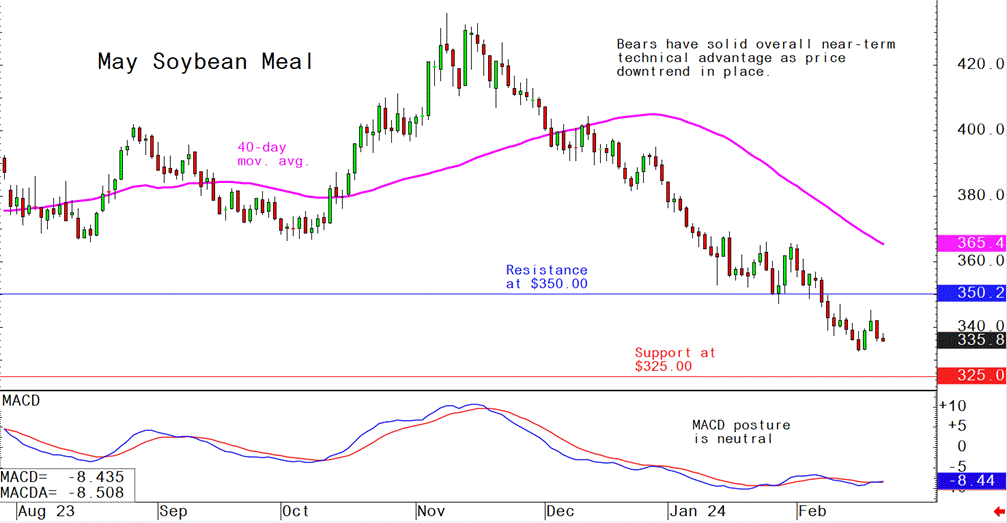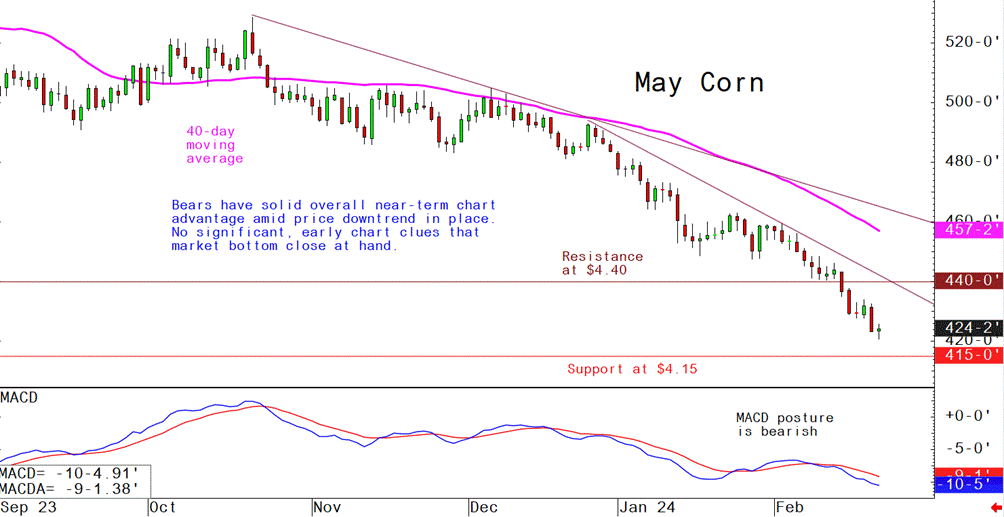



Pig outlook — Lean hog futures bulls keep price uptrend alive
Analyst Jim Wyckoff reports on global pig newsApril lean hog futures this week hit an eight-month high and the bulls have the firm near-term technical advantage. Prices are in a seven-week-old uptrend on the daily bar chart. The latest CME lean hog index jumped another $1.17 to $77.97 as of Feb. 20, marking back-to-back days of $1.00-plus gains. The cash index is outpacing futures, with the premium in the April contract down to $8.005 as of Wednesday’s close. Meantime, wholesale pork prices continued to decline at mid-week after surging higher Monday, led by weakness in bellies. Pork movement remains relatively light considering the recent surge in cutout values, which suggests packer marketings are more current as production has fallen in the last couple of weeks.
USDA annual Ag Outlook Forum forecast highlights for US pork
Despite poor returns for much of 2023, the hog sector is looking at increased production in 2024. The December 2023 Quarterly Hogs and Pigs report estimated that on December 1, 2023, the inventory of all hogs and pigs was just under 75.0 million head, virtually unchanged from the prior year. The breeding herd, however, likely reflected weak producer margins, declining 3 percent to 6.0 million head. Producers indicated intentions to farrow about 1.5 percent few hogs in the first half of 2024. However, the sector is facing relatively large number of hogs which will have to be slaughtered during the first half of 2024 as the pig crop in the second half of 2023 was about unchanged from 2022.
Despite reduced farrowings in second-half 2023, the rate of growth in pigs per litter in the last 2 quarters of 2023 averaged about 4 percent more than the prior year and more than offset the reduction in farrowings. Moving into the second half of 2024, availability of hogs for slaughter will reflect lower farrowing in the first half of the year but likely a return to pre-COVID rates of growth in prigs per litter. As a result, the first half pig crop may be about one percent higher and these higher numbers will be reflected in continued higher year-over-year levels of slaughter.
U.S. hog imports are forecast at just under 6.65 million head for 2024, down about 2 percent from 2023. Imports in 2023 were stimulated by structural changes in the Canadian hog and pork sectors which resulted in increased shipments to the United States. As Canadian hog production in 2024 is forecast to be lower, fewer supplies are expected to be available for export. Furthermore, relatively large supplies of hogs in the U.S. may limit the demand for Canadian hogs. Driven by larger pig crops in second-half 2023 and first-half 2024, commercial pork production for 2024 is forecast at 27.88 billion pounds, about 2 percent higher than 2023. In addition to increased supplies of market-ready hogs during the year, carcass weights are expected to increase after declining in 2023. Pork exports in 2023 increased just over 7 percent to 6.82 billion pounds.
Exports to most countries in North and Central America countries were higher. Shipments to Mexico increased almost 10 percent, 5 exports to Canada were 8 percent higher and exports to Central America and the Caribbean were about 16 percent higher. On the other side of the world, the trade situation was more of a mixed bag with exports to Japan and China one percent and 18 percent lower, respectively, but exports to South Korea 10 percent higher and shipments to Australia up 90 percent. However, in both China and Japan, where aggregate imports were lower, the U.S. was able to gain or maintain market share, largely at the expense of the EU which had lower production in 2023. With expectations of growth in U.S pork production, firming global demand and continued constraints on EU supplies, U.S. exports in 2024 are forecast to increase about 4 percent to 7.08 billion pounds. However, U.S. exporters will likely find themselves facing increased competition in a number of key markets from expanded Brazilian supplies.
US pork imports declined 15 percent in 2023 to 1.14 billion pounds. Imports from three of the four major import sources (Canada, the EU, and Mexico) declined at double-digit rates, but imports from Brazil, the fourth largest source of imports was higher. Despite higher domestic U.S. production, increased production in Mexico and Brazil will likely make the U.S. an attractive destination for pork. However, continued tight supplies in the EU may limit imports from that region although demand may remain strong for certain specialty products. U.S. imports are expected to increase in 2024 to 1.20 billion pounds, 5 percent higher than 2023. National base 51%-52% lean hog prices, live equivalent, are forecast to average $60 per cwt for 2024, up from last year’s $58.59. Despite increased availability of hogs, expected increases in both domestic and export demand are expected to provide support for prices.
The next week’s likely high-low price trading ranges:
April lean hog futures--$83.00 to $89.00 and with a sideways-higher bias
May soybean meal futures--$325.00 to $350.00, and with a sideways-lower bias
May corn futures--$4.15 to $4.40 and a sideways-lower bias
Latest analytical daily charts lean hog, soybean meal and corn futures












